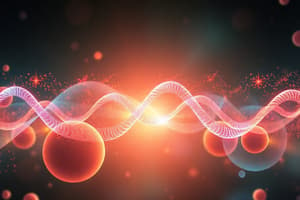Podcast
Questions and Answers
Which steps of glycolysis is irreversible?
Which steps of glycolysis is irreversible?
- Reaction 1, 3 and 10 (correct)
- Reaction 1, 5 and 7
- Reaction 2, 6, and 8
- Reaction 4, 6 and 10
Which enzyme is responsible for Reaction 1 of glycolysis?
Which enzyme is responsible for Reaction 1 of glycolysis?
- Enolase
- Aldolase
- Phosphoglucose isomerase
- Hexokinase (correct)
What is the role of Mg2+ in Reaction 1 of glycolysis?
What is the role of Mg2+ in Reaction 1 of glycolysis?
- Cofactor for Hexokinase (correct)
- Cofactor for Aldolase
- Cofactor for Phosphoglucose isomerase
- Cofactor for Enolase
Why is glucose trapped in the cell after Reaction 1 of glycolysis?
Why is glucose trapped in the cell after Reaction 1 of glycolysis?
Which step of glycolysis requires an input of energy through ATP?
Which step of glycolysis requires an input of energy through ATP?
Which step of glycolysis produces energy directly?
Which step of glycolysis produces energy directly?
What is the energy yield from a cycle of glycolysis?
What is the energy yield from a cycle of glycolysis?
Which reaction is the rate-limiting and committing step of glycolysis?
Which reaction is the rate-limiting and committing step of glycolysis?
Which reaction in glycolysis is the most important regulated reaction?
Which reaction in glycolysis is the most important regulated reaction?
How many ATP molecules are required during the preparatory phase of glycolysis?
How many ATP molecules are required during the preparatory phase of glycolysis?
How many ATP molecules are created during the generating phase of glycolysis?
How many ATP molecules are created during the generating phase of glycolysis?
How many NADH molecules are generated per glucose molecule in glycolysis?
How many NADH molecules are generated per glucose molecule in glycolysis?
Under aerobic conditions, where does pyruvate go next?
Under aerobic conditions, where does pyruvate go next?
Which reactions in glycolysis are irreversible?
Which reactions in glycolysis are irreversible?
Which of the following is a symptom commonly seen in individuals with inherited disorders of gluconeogenesis?
Which of the following is a symptom commonly seen in individuals with inherited disorders of gluconeogenesis?
What is the underlying cause of the main symptoms of inherited disorders of gluconeogenesis?
What is the underlying cause of the main symptoms of inherited disorders of gluconeogenesis?
Which of the following is a possible treatment for inherited disorders of gluconeogenesis?
Which of the following is a possible treatment for inherited disorders of gluconeogenesis?
Which of the following is a precursor for gluconeogenesis?
Which of the following is a precursor for gluconeogenesis?
Which shuttle system is used when the starting substrate for gluconeogenesis is alanine?
Which shuttle system is used when the starting substrate for gluconeogenesis is alanine?
Which of the following amino acids is considered a glucogenic amino acid?
Which of the following amino acids is considered a glucogenic amino acid?
What coenzyme is required for the transamination reaction that converts alanine to pyruvate?
What coenzyme is required for the transamination reaction that converts alanine to pyruvate?
What are the products of the citric acid cycle?
What are the products of the citric acid cycle?
What are the products of the CAC?
What are the products of the CAC?
Which of the following is true about the laws of thermodynamics?
Which of the following is true about the laws of thermodynamics?
What does Gibbs Free Energy measure?
What does Gibbs Free Energy measure?
How does Gibbs Free Energy relate to spontaneity?
How does Gibbs Free Energy relate to spontaneity?
What is the relationship between Gibbs Free Energy and biology?
What is the relationship between Gibbs Free Energy and biology?
What happens to pyruvate under aerobic conditions?
What happens to pyruvate under aerobic conditions?
What is the role of Mg2+ in Reaction 1 of glycolysis?
What is the role of Mg2+ in Reaction 1 of glycolysis?
Which of the following is a statement of the first law of thermodynamics?
Which of the following is a statement of the first law of thermodynamics?
Which of the following is true about exothermic reactions?
Which of the following is true about exothermic reactions?
What happens to the entropy of a system when energy disperses or spreads out?
What happens to the entropy of a system when energy disperses or spreads out?
Which of the following is the correct equation for Gibbs Free Energy?
Which of the following is the correct equation for Gibbs Free Energy?
What does a negative value of Gibbs Free Energy indicate?
What does a negative value of Gibbs Free Energy indicate?
When is a reaction at equilibrium?
When is a reaction at equilibrium?
How does the Gibbs free energy change when the reactants are increased compared to the products?
How does the Gibbs free energy change when the reactants are increased compared to the products?
Even reactions with a fairly large positive ΔG can develop into exergonic reactions if _____________.
Even reactions with a fairly large positive ΔG can develop into exergonic reactions if _____________.
How is it possible for a reaction with a positive standard Gibbs free energy (ΔGo') to occur in our bodies?
How is it possible for a reaction with a positive standard Gibbs free energy (ΔGo') to occur in our bodies?
What is the role of enzymes in coupled reactions?
What is the role of enzymes in coupled reactions?
What is the rationale for why the body phosphorylates ATP as a source of energy currency?
What is the rationale for why the body phosphorylates ATP as a source of energy currency?
How do enzymes help in coupled reactions?
How do enzymes help in coupled reactions?
What does this describe:
amino groups are removed from amino acids and transferred to acceptor keto-acids to generate the amino acid version of the keto-acid and the keto-acid version of the original amino acid.
What does this describe:
amino groups are removed from amino acids and transferred to acceptor keto-acids to generate the amino acid version of the keto-acid and the keto-acid version of the original amino acid.
Flashcards are hidden until you start studying





